How to properly use a gas cylinder at home: instructions + valuable tips
Do you think that the lack of gas in a populated area is a serious reason to refuse to use blue fuel? Agree that even in the absence of a gas main, you can always organize the operation of a gas stove, heater or water heater. It is enough to purchase and refill a household gas cylinder to experience all the benefits of civilization.
We will tell you about the existing types of cylinders and how to properly use a gas cylinder at home. The article we have proposed describes in detail how to connect the equipment and refill an empty cylinder.
Frightening news about domestic gas explosions is increasingly heard on television screens. We list all safety measures for the operation of gas equipment. Knowing the requirements, you will be able to use gas cylinders without fear and not worry about your life, health and the lives of loved ones.
The content of the article:
Types of household gas cylinders
In the vast majority of everyday life, gas cylinders are used to organize the operation of kitchen stoves. Therefore, this review will focus on this particular method of operation.
Depending on the type of material used, gas cylinders are:
- Steel;
- Polymer-composite;
- Metal-composite.
The most common are steel (metal) cylinders.It was with them that the era of mobile gasification began.
Despite multiple disadvantages (heavy weight, unsafety, susceptibility to corrosion, opacity), these cylinders are in great demand due to their availability and low price.
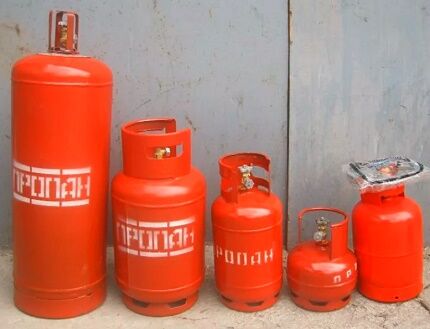
Polymer-composite cylinders are 35-40% lighter than steel ones, because they are made from fiberglass filled with epoxy resin. Such cylinders are explosion-proof and impact-resistant, which is ensured by a protective casing.
They are non-corrosive, transparent, and equipped with a bypass valve. True, they have a smaller volume than their steel counterparts, and their price is an order of magnitude higher.
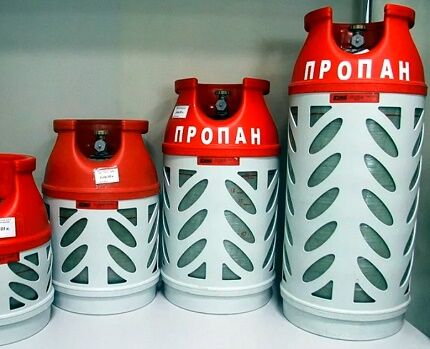
Metal-composite cylinders are a cross between polymer-composite and steel. In terms of safety and impact resistance, they are inferior to polymer-composite products.
Advantages and disadvantages of gas cylinders
To answer the question whether it is possible to use gas cylinders in everyday life, you need to understand all their strengths and weaknesses. An autonomous gas cylinder is an indispensable thing in the absence of a centralized gas supply.
But it will not interfere with the housework and, so to speak, just in case of fire. After all, it often happens that gas supplies are suspended for maintenance and repair work.
The main advantages of using gas in cylinders:
- Mobility – the tank can be transported and rearranged;
- Storage duration – a cylinder filled with gas can be stored for several years;
- Big choice – you can purchase a cylinder of various sizes.
The disadvantages are mainly related to the danger that can arise from connection and operation errors:
- Fire and explosion hazard. If there is a sharp rise in temperature or a fire, a metal cylinder can explode, causing significant damage to the home and the health of people caught in the explosion zone.
- Danger of inhaling gas. Cylinders can leak gas, and a propane-butane mixture at high concentrations can lead to death. This is possible in the event of a leak when the cylinder is in a residential area.
- Danger from sudden overturning. Due to a pressure surge, a sudden burst of flame is possible, which can result in damage to gas equipment.
When following the rules and regulations for the operation of gas equipment, the risks from their use are minimized.
Safe operation of household gas cylinders
To understand how to safely use a gas cylinder, you need to look in more detail at their connection, installation, operation and refueling.
Connecting a gas cylinder to consumption devices
It's not enough to have gas cylinder and the device to which it will be connected.
Autonomous gasification requires the presence of a whole system of equipment:
- A device that will be “powered” by gas (stove, water heater, grill, etc.);
- Gas cylinder;
- Gas hose;
- Gearbox;
- Clamps for securing the hose.
The pressure in the gas cylinder depends on the temperature and is not constant. Therefore, to level it, use gas reducer, which not only reduces, but also equalizes the pressure to the value necessary for normal operation of the equipment.
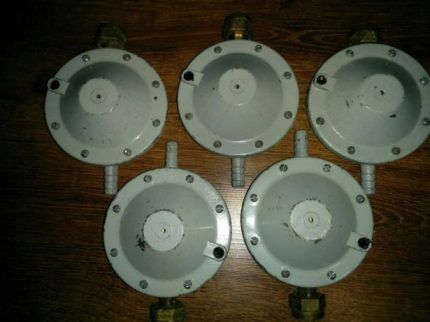
The reducer is screwed onto the valve fitting and connected to the gas consumption device using a hose. All threaded connections are pre-wound with 3-4 layers of gas fum tape. The connecting hose at the place of fixation must be additionally secured using steel clamps.
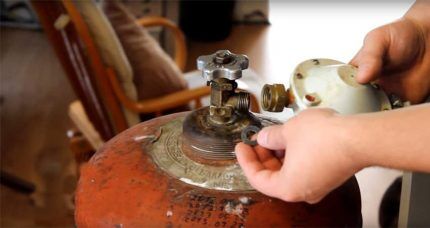
All connections should be checked for tightness. The reliability of the connection is checked by applying soap foam - the presence of bubbles indicates insufficient tightness. To eliminate the leak, tighten the nut connecting the fitting to the gearbox with great force.
If a gas leak is detected in the area of the connecting hose, then it is necessary to tighten the clamp bolts. After completing the adjustment, it is necessary to re-check using soap foam. A similar check should always be performed when connecting a gas cylinder, both for the first time and after replacing it.
Some gas technicians check for gas leaks using a lit match. This method of checking leaks is prohibited by safety standards. Firstly, in daylight, small flames can simply not be noticed. Secondly, a significant gas leak can lead to fire and even an explosion.
Safety requirements for the operation of gas cylinders
One of the most important criteria for the safe operation of a gas cylinder is constant monitoring of overheating and possible leakage. By her own propane-butane mixture It is odorless, but the presence of hydrocarbon-mercaptan in the composition makes it possible to detect a leak.
Basic safety requirements for using bottled gas:
- Gas-related equipment must be in good working order. A technical inspection of cylinders should be carried out at least once every 5 years. When connecting or replacing a cylinder, check the tightness of all connections using a soap solution.
- Do not use cylinders with traces of rust, with a faulty valve, or without gas markings.
- The cylinder should be stored in a special ventilated cabinet that protects the cylinder from exposure to direct sunlight and precipitation. The distance from the cabinet to the window or door must be at least 1 m.
- When placed indoors, the distance to a source with an open flame must be at least 5 m. Also, the distance to heat sources (heating radiators, electric heaters, etc.) must be at least 1 m. Large capacity cylinders should be placed in a special cabinet with the outside of the home.
- It is prohibited to store cylinders in the basement or bury them in the ground.
- In working condition, the cylinder must be in a vertical position.
- When replacing the cylinder, you need to make sure that there are no sources of fire.
Never neglect the above rules for the safe use of bottled gas, as even the slightest violation can become a threat to life.
What to do if a gas leak is detected?
Gas leaks can be detected visually using soap suds. Most often, leaks occur in fittings or hose connections.
A strong leak can be detected by ear; at a minimum, this will serve as a hint for where to apply the soap solution. Another factor for controlling leakage is the appearance of a characteristic odor.
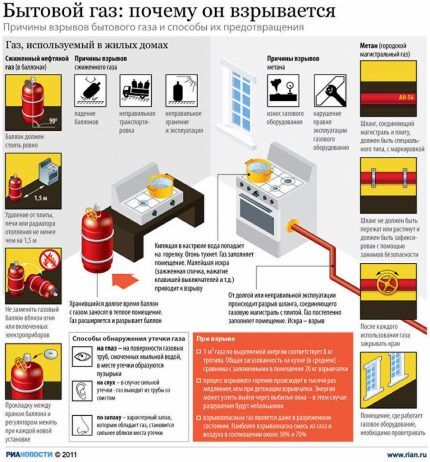
The danger is that the propane-butane mixture is heavier than air, so if there is a leak, the gas rushes to the floor and can accumulate under the floor or in the basement. One spark will be enough to trigger an explosion. The main cause of a gas explosion is most often negligence and disregard for safety standards.
To avoid the risk of carbon monoxide poisoning and prevent the possibility of an explosion, set yourself the following rules for using a gas cylinder in your home:
- Installation of gas detectors near the floor;
- Ventilate the room before opening the cylinder valve;
- Gas appliances that are switched on must be under constant supervision;
- Gas stoves cannot be used for heating or warming a room;
- Gas cylinders, like gas equipment, should only be repaired by specialists;
- If residents are absent for a long period of time, gas cylinders should be taken outside the home.
If a gas leak does occur, it is prohibited to use any electrical appliances. Do not perform activities that cause sparks to form.
If a leak is detected, the cylinder must be closed immediately gas cylinder valve, disconnect it from gas-powered appliances and take it outside.Everything must be done quickly and carefully, as falling of the cylinder can lead to a fire.
If gas leaks from the cylinder, it may ignite. The first step is to try to turn off the valve. In case of a small flame, you can try to extinguish it with a wet towel, and then take the cylinder outside. Extinguishing a large flame is risky, as the accumulated gas in the room can explode.
Remember that overheating the cylinder to 180 degrees can cause it to an explosion. While the gas is burning, the likelihood of an explosion is minimal; an explosion is possible if the cylinder overheats from objects burning nearby. Therefore, immediately after a fire, you need to turn off the valve, remove the cylinder from the room and call emergency services.
Features of operation of gas cylinders
The liquefied gas in the cylinder is under pressure, and when it is supplied to gas equipment, it transforms into a gaseous state.
This process is accompanied by a sharp decrease in temperature, and with intensive use of the equipment, the temperature can drop to a critical value at which further conversion becomes impossible.
The simplest solution is to reduce gas consumption. You can also resort to additional heating of the cylinder, but it is prohibited to use heating sources with an open flame. Insulation of gas cylinders is not allowed, but it is possible to use special “heating jackets” and thermal covers.
Owners of gas cylinders may encounter similar difficulties in winter if the cylinders are located in an unheated room.In this case, it is best to use special propane-butane mixtures with different percentages of components.
The standard gas mixture for the warm season contains 60% butane, 40% propane. A winter mixture for critically low temperatures may contain 80% propane and 20% butane, but such a mixture is much more expensive.
Refilling gas cylinders
It is recommended to refill household gas cylinders at specialized “gas filling points”. In addition to compliance with filling standards, each tank is guaranteed to be checked for leaks, compliance with service life, and the presence of sediment in the form of heavy fractions.
When filling a cylinder with a propane-butane mixture, it must be taken into account that the filling should be no more than 85%. Not every gas station has the necessary cut-off valves, and refueling is done by volume, not by weight, which can lead to increased pressure in the cylinder.
If you are sure that the cylinder is in good condition, the gasoline has been checked and removed, then refueling can be carried out at a gas station.
However refueling at a gas station is acceptable provided that the refueling process is carried out not by the volume of blue fuel, but by its weight, which is controlled using electronic scales.
Conclusions and useful video on the topic
Marking of technical examination of household gas cylinders:
Safety rules for the operation of household propane-butane cylinders:
Requirements and operating rules for gas cylinders: myths and reality:
Gas cylinders are an integral attribute of any owner of a summer house or house whose home is located outside the centralized gas supply.
Compliance with the rules for connecting and replacing cylinders, standards for their operation and refueling not only guarantees the safety of residents, but also ensures comfort from the use of almost any gas appliances.
Please write comments in the block form located below the text of the article. Tell us about your experience in using bottled gas. Share useful information that may be useful to site visitors, ask questions, post pictures related to the topic of the article.
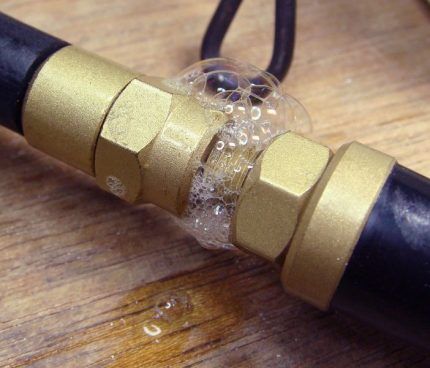

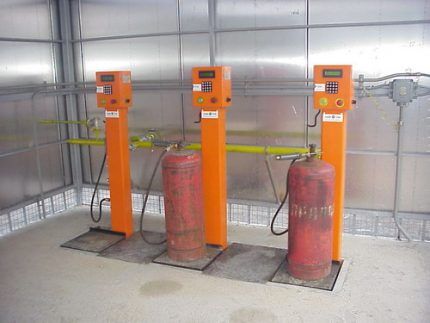




Good afternoon ! I purchased a garden (dacha) with a garden house. There is a gas stove in the kitchen, and a gas cylinder (50 l) in the garage attached to the house. I would like to carry out diagnostics of the entire existing gas equipment system to understand the possibility of its safe operation. Who (what authorized organization) can I contact for this service (conclude an agreement), incl. for periodic replacement of the gas cylinder? I live in the Chelyabinsk region